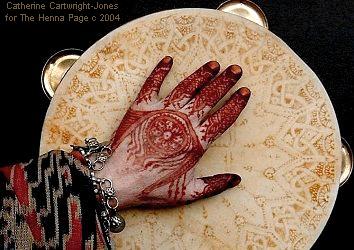The Encyclopedia of Henna

Henna and the Insurrection
in the Hadramaut
Catherine Cartwright-Jones c 2004
Kent State University

|
When the Prophet
Mohammed died in 632 CE, many Arab tribes
refused to pay taxes to the Prophet’s successor, Abu Bakr, the first
Caliph. In some
regions, there was open rebellion against the recently established,
fragile, Islamic state. In the Kinda and
Hadramaut regions of Yemen,
a group of six women celebrated the Prophet’s death with feasting and
joy. They
hennaed their hands, sang victory songs, danced, and played their
tambourines. Twenty two other women came
out to join the political rebellion. They
also hennaed in celebration of the victory. Two of these rebellious women were
grandmothers, one was a mother,
and several were
young girls, three of noble class, and four of a royal tribe. The
leaders of Yemen came from this royal tribe. Their rebellion against
the Islamic state was significant, as women in Yemen were
politically powerful, and only their sons would rule the
region. Women in Yemen had been political and military rulers and
strategists since the time of the Queen of Sheba and before. If these
women's revolt against the Caliph gained support, the Islamic domain
over the valuable area of the Yemen could collapse. The ruler of Kinda in Yemen wrote a complaint to the Caliph about the women's victory celebration, as it threatened to undermine his authority and destabilize the region. The Caliph received these complaints of insurrection, and ordered the women’s hennaed hands to be cut off as retaliation for their rebellion. He also ordered that anyone who defended these rebels, or interfered with soldiers coming to enact the Caliph's judgment, be beheaded. The fact that the women had hennaed their hands was crucial evidence of their guilt, because the henna stains would remain on the women’s hands for some time as evidence. Their palm stains would last for a month, and their fingernails would betray their participation in the insurrection for up to six months. Those who participated in the act of rebellion would be easily identified by their henna stains. Women who had mourned for the death of The Prophet would not have used henna, as henna is eschewed during the period of mourning. The murder of honorable, noble women would have been an unforgivable crime, and kinsmen would have rushed for vengeance, destabilizing the political structure in the region. With only their hands were cut off, God's mercy potentially allowed them to survive the mutilation. The punishment was delineated as a punishment for the hands which celebrated a blasphemy, carefully sidestepping their nobility and deterring further rebellion. With the women’s honor impugned, mutilations went uncontested, and the potential military insurrection was crushed. References: Beeston, A.F. L The So-Called Harlots of Hadramaut Oriens V, 1952 Ibn Habib Al-Bagdhadi, M. Kitab al-Muhabbar Hyderabad, 1942 Mernisi, F. Beyond the Veil, Male-Female Dynamics in Modern Muslim Society Indiana University Press. 1975 Field, Henry Body-Marking in Southwestern Asia Papers of the Peabody Museum of Archaeology and Ethnology, Harvard University Vol. XLV, No 1 Peabody Museum, Cambridge Massachusetts, USA Return to The Encyclopedia of Henna Index Return to the War Index Can't find what you're looking for? Try: The Henna Page Main Index http://www.hennapage.com/henna/mainindex.html *"Henna,
the
Joyous Body Art"
the Encyclopedia of Henna Catherine Cartwright-Jones c 2000 registered with the US Library of Congress TXu 952-968 |
